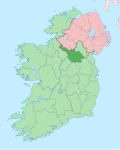Geography
Dunmakeever is bounded on the north by Aghatirourke, Gortmaconnell, Legnabrocky, Aghnahoo, Tromogagh and Legg, County Fermanagh townlands, on the east by Alteen, Bursan and Commas (Kinawley) townlands, on the south by Tonanilt, Tullyminister and Corracleigh townlands and on the west by Tullycrafton, Ardvagh and Tullynacross (Glangevlin) townlands. Its chief geographical features are Cuilcagh Mountain reaching an altitude of 2,200 feet, Dunmakeever Lough, Dunmakeever Lough North, the Owenmore River (County Cavan) and several waterfalls. Dunmakeever is traversed by the R200 road from Ballinamore to Glangevlin and some minor lanes. The townland covers an area of 1,233 statute acres.
History
In the 1609 Plantation of Ulster, Dunmakeever formed part of lands which were granted to John Sandford of Castle Doe, Co. Donegal by letters patent dated 7 July 1613 (Pat. 11 James I – LXXI – 38, 'Glangewley' & 'Quilkagh'). It was later sold by Sandford to his wife's uncle, Sir Toby Caulfeild, 1st Baron Caulfeild, Master of the Ordnance. Sir Toby had the sale confirmed by letters patent of 12 July 1620 (Pat. 19 James I. XI. 45).
A deed by Thomas Enery dated 29 Jan 1735 includes the lands of Dunmaguire. [1]
A deed dated 13 Nov 1738 includes the lands of Dunmaguier. [2]
In the 1821 census of Ireland, there are ten families listed in the townland and it states- Doonmakeever contains 100 acres of green pasture & 500 acres of BlackRock mountain. [3]
The 1825 Tithe Applotment Books spell the name as Doonmaquiver. [4]
In 1841 the population of the townland was 93, being 49 males and 41 females. There were thirteen houses in the townland and all were inhabited. [5]
In 1851 the population of the townland was 96, being 51 males and 45 females. There were sixteen houses in the townland and all were inhabited. [5]
Griffith's Valuation of 1857 lists fourteen occupiers in the townland. [6]
In 1861 the population of the townland was 95, being 52 males and 43 females. There were fifteen houses in the townland and all were inhabited. [7]
In 1871 the population of the townland was 96, being 56 males and 40 females. There were fifteen houses in the townland and all were inhabited.(page 296 of census) [8]
In 1881 the population of the townland was 105, being 61 males and 44 females. There were fifteen houses in the townland, all were inhabited. [9]
In 1891 the population of the townland was 107, being 59 males and 48 females. There were sixteen houses in the townland, all were inhabited. [10]
In the 1901 census of Ireland, there are fourteen families listed in the townland. [11]
In the 1911 census of Ireland, there are eighteen families listed in the townland. [12]
This page is based on this
Wikipedia article Text is available under the
CC BY-SA 4.0 license; additional terms may apply.
Images, videos and audio are available under their respective licenses.


